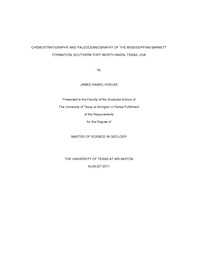
ATTENTION: The works hosted here are being migrated to a new repository that will consolidate resources, improve discoverability, and better show UTA's research impact on the global community. We will update authors as the migration progresses. Please see MavMatrix for more information.
Show simple item record
| dc.contributor.author | Hoelke, James Daniel | en_US |
| dc.date.accessioned | 2011-10-11T20:48:33Z | |
| dc.date.available | 2011-10-11T20:48:33Z | |
| dc.date.issued | 2011-10-11 | |
| dc.date.submitted | January 2011 | en_US |
| dc.identifier.other | DISS-11305 | en_US |
| dc.identifier.uri | http://hdl.handle.net/10106/6164 | |
| dc.description.abstract | The Mississippian (Visean-Serpukhovian) Barnett Formation is a lithologic unit composed primarily of laminated siliceous mudstone and calcareous siliceous mudstone with significant phosphate and sulfide phases present. The Barnett Formation was deposited in the Fort Worth Basin, a marine foreland basin that formed as a result of the early Ouachita Orogeny from the collision of Laurasia and Gondwana. In this study we used a variety of geochemical methods to provide a detailed assessment of the chemostratigraphy and paleoceanography of the Barnett Formation in the southern end of the Fort Worth Basin in Texas. Various aspects of the Barnett Formation studied include: degree of basin restriction and deep-water renewal time, redox conditions, organic composition, paleoclimatic indicators, and bulk geochemistry. Eight drill cores along a northeast-southwest transect of the basin in central Texas were evaluated for this study. Each core was scanned at a 1-foot (~0.3m) interval with an X-ray fluorescence (XRF) spectrometer to provide quantitative analysis of major (e.g. Fe, Si, Al) and trace (e.g. Mo, U, V) elements. In addition, total organic carbon (TOC), total inorganic carbon (TIC), percent total nitrogen, and stable isotope (d13C, d15N) data were gathered from five of the cores. Percent sulfur data were gathered from three of the cores. The physical paleoceanography of the Barnett Formation reveals that the area of Barnett deposition in the southern Fort Worth Basin was hydrographically restricted. The southern basin was more restricted than comparable modern anoxic basins during Barnett time. This basin restriction led to deep-water renewal times longer than those of comparable modern anoxic basins and shorter than those for the Barnett Formation of the northern Fort Worth Basin. Deep-water renewal times for the southern basin range from 557-1383 years. The chemical paleoceanography of the Barnett Formation reveals that the Barnett strata were deposited under anoxic to euxinic conditions for essentially the entire depositional timeframe in the mid-late Mississippian. The southernmost end of the transect was deposited initially under anoxic conditions and later under oxic conditions. In addition, high d15N values (average 7.76) indicate intensified denitrification occurred in the water column. The Barnett strata in the southern Fort Worth Basin is organic rich with total organic carbon (TOC) ranging from 0.07-13.25% with an average TOC of 4%. The organic matter was determined to be primarily of marine origin. The organic matter had d13Corg values ranged from -24 to -32 with an average d13Corg value of -30. The carbon-nitrogen ratio values ranged from 1.6 to 92.3 with an average C/N ratio of 21.78. The Barnett Formation was deposited during a second-order eustatic high stand during a warmer, interglacial period based upon stable nitrogen isotope ratios. The bulk geochemistry of the Barnett Formation indicates that it is composed primarily of siliceous mudstone and calcareous siliceous mudstone with significant phosphate and sulfide phases present. | en_US |
| dc.description.sponsorship | Rowe, Harold | en_US |
| dc.language.iso | en | en_US |
| dc.publisher | Geology | en_US |
| dc.title | Chemostratigraphy And Paleoceanography Of The Mississippian Barnett Formation, Southern Fort Worth Basin, Texas, USA | en_US |
| dc.type | M.S. | en_US |
| dc.contributor.committeeChair | Rowe, Harold | en_US |
| dc.degree.department | Geology | en_US |
| dc.degree.discipline | Geology | en_US |
| dc.degree.grantor | University of Texas at Arlington | en_US |
| dc.degree.level | masters | en_US |
| dc.degree.name | M.S. | en_US |
Files in this item
- Name:
- Hoelke_uta_2502M_11305.pdf
- Size:
- 3.574Mb
- Format:
- PDF
This item appears in the following Collection(s)
Show simple item record


